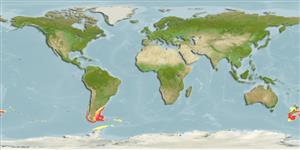>
Gadiformes (Cods) >
Gadidae (Cods and haddocks)
Etymology: Micromesistius: Greek, mikros = small + greek, mesos = middle + Greek, istion = sail (Ref. 45335).
More on author: Norman.
Environment: milieu / climate zone / depth range / distribution range
Ekologi
laut bentopelagis; oceanodromus (Ref. 51243); kisaran kedalaman 50 - 900 m (Ref. 27363), usually 200 - 400 m (Ref. 7061). Temperate; 37°S - 65°S, 165°E - 34°W (Ref. 54589)
There are 2 disjunct populations. Micromesistius australis australis occurs around the Falkland Islands and Argentine Patagonia in the southwest Atlantic; off Chile in the southeast Pacific; also off South Georgia, South Shetland and South Orkney islands. Micromesistius australis pallidus occurs around the South Island of New Zealand.
Length at first maturity / Size / Weight / umur
Maturity: Lm 33.7, range 33 - 40 cm
Max length : 90.0 cm TL jantan/; (Ref. 1371); common length : 60.0 cm TL jantan/; (Ref. 1371); Berat maksimum terpublikasi: 850.00 g (Ref. 4883); Umur maksimum dilaporkan: 30 Tahun (Ref. 7059)
Duri punggung (Keseluruhan (total)) : 0; duri punggung lunak (Keseluruhan (total)) : 43 - 55; Duri dubur: 0; Sirip dubur lunak: 56 - 71; vertebrata, bertulang belakang: 54 - 57.
Invades shelf waters during summer and concentrating over the continental slope in winter. Forms schools (Ref. 9072). The young feed on euphausiids and amphipods and occasionally on copepods, cephalopods and small fish. Utilized in frozen blocks and as fishmeal. In Japan used as suerii (minced meat) for karaoke (fish cake) (Ref. 27363). Can be fried, microwaved and baked (Ref. 9988).
Oviparous, sexes are separate (Ref. 205).
Cohen, D.M., T. Inada, T. Iwamoto and N. Scialabba, 1990. FAO species catalogue. Vol. 10. Gadiform fishes of the world (Order Gadiformes). An annotated and illustrated catalogue of cods, hakes, grenadiers and other gadiform fishes known to date. FAO Fish. Synop. 125(10). Rome: FAO. 442 p. (Ref. 1371)
Status IUCN Red List (Ref. 130435: Version 2024-1)
ancaman kepada manusia
Harmless
penggunaan manusia
Perikanan: bernilai komersial tinggi
Alat, peralatan
laporan khas
muat turun XML
Sumber internet
Estimates based on models
Preferred temperature (Ref.
123201): 3.4 - 9.1, mean 5.8 °C (based on 109 cells).
Phylogenetic diversity index (Ref.
82804): PD
50 = 0.7500 [Uniqueness, from 0.5 = low to 2.0 = high].
Bayesian length-weight: a=0.00372 (0.00221 - 0.00624), b=3.14 (2.99 - 3.29), in cm total length, based on LWR estimates for this species & (Sub)family-body (Ref.
93245).
Trophic level (Ref.
69278): 3.8 ±0.50 se; based on food items.
Daya lenting (Ref.
120179): sedang, Waktu penggandaan populasi minimum 1.4 - 4.4 tahun (K=0.18; tm=2-5; tmax=30).
Prior r = 0.54, 95% CL = 0.36 - 0.82, Based on 5 data-limited stock assessments.
Fishing Vulnerability (Ref.
59153): Moderate to high vulnerability (52 of 100).
Climate Vulnerability (Ref.
125649): Moderate to high vulnerability (53 of 100).
Nutrients (Ref.
124155): Calcium = 38.2 [10.7, 99.6] mg/100g; Iron = 0.368 [0.123, 1.121] mg/100g; Protein = 16.3 [14.4, 18.6] %; Omega3 = 0.381 [0.149, 0.940] g/100g; Selenium = 12.1 [3.0, 42.1] μg/100g; VitaminA = 9.29 [1.98, 46.46] μg/100g; Zinc = 0.673 [0.286, 1.563] mg/100g (wet weight); based on
nutrient studies.
